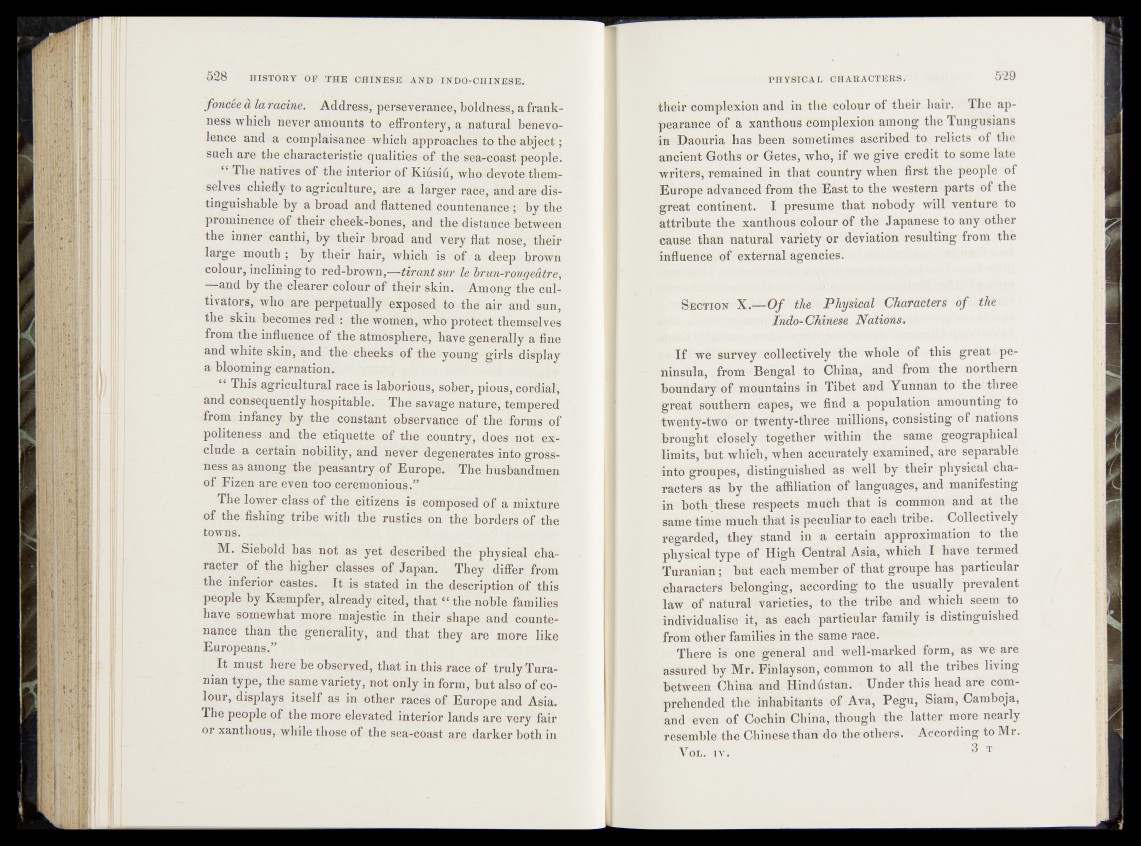
foncee d la racine. Address, perseverance, boldness, a frankness
which never.amounts to effrontery, a natural benevolence
and a complaisance which approaches to the abject;
such are the characteristic qualities of the sea-coastfpeople.
“ The natives of the interior of KiUsiU, who devote themselves
chiefly to agriculture, are a larger race, and are distinguishable
by a broad and flattened countenance ;' by the
prominence of their cheek-bones, and the distance between
the inner canthi, by their broad and very flat nose, their
large mouth ; by their hair, which is of a deep; brown
colour,.inclining to red-brown,—tirant sur le brun-rouge&tre-^
—and by the clearer colour of their skin. Among the Cultivators,
who are perpetually exposed to the air &ud 'sun,
the skin becomes red : the women, who protect themselves
from, the influence of the atmosphere, have generally a fine
and white skin, and the cheeks of the young girls display
a blooming carnation.
This agricultural race is laborious, sober, pious, cordial,
and consequently hospitable. The savage nature, tempered
from infancy by the constant observance of the forms of
politeness and the etiquette of the country, does not « exclude
a certain nobility, and never degenerates into groSs-
ness as among the peasantry of Europe. The husbandmen
of Fizen are even too ceremonious.”
The lower class of the citizens is composed of a mixture
of the fishing tribe with the rustics on the borders of the
towns.
M. Siebold has not as yet described the physical character
of the higher classes of Japan. They differ from
the inferior castes. It is stated in the description of this
people by Ksempfer, already cited, that “ the noble families
have somewhat more majestic in their shape and countenance
than the generality, and that they are more like
Europeans.”
It must here be observed, that in this race of truly Turanian
type, the same variety, not only in form, but also of colour,
displays itself as in other races of Europe and Asia.
The people of the more elevated interior lands are very fair
or xanthous, while those of the sea-coast are darker both in
their complexion and in the colour of their hair. The appearance
of a xanthous complexion among the Tungusians
in ©aouria has been sometimes ascribed, to relicts of the
ancient Goths or Gette&i who, if we give credit to some late
writers«, remained in that country when first the people of
Europe advanced from, the East to the western parts of the
great continent. 1 jfitóhme that nobody will venture to
attribute the xanthous colour of thé^ Japanese to any other
cause than natural variety ör deviation resulting from the
influence of external ageiciesl
« S ec t ion X .—Of the Physical Oharmters of the
Indo- Chinese Nations.
If we survey collectively the whole of this great peninsula,
from Bengal to China, and from the northern
boundary of mountains in Tibet and Yunnan to the three
great southern capes* we find a population amounting to
twenty-two-or twenty-three millions, consisting of nations
brought closely together within the same geographical
limits, but which* when accurately examined, ate separable
into groupés, distinguished as well by their physical characters
as by the affiliation of languages, and manifesting
in both these respects mufch that is common and at the
same time much, that is peculiar to each tribe. Collectively
regarded* they stand in a certain approximation to the
physical type of High Central Asia, which I have termed
Turanian ; but each member of that groupe has particular
characters belonging, according to the usually prevalent
law of natural Varieties, to the tribe and which seem to
individualise it* as each particular family is distinguished
from other families in the same race. '
There is one general and Well-marked form, as we are
assured by Mr. Finlaysöfi, common to all the tribes living
between China and Hindustan. Under this head are comprehended
thé inhabitants of A va, Pegu, Siam, Camboja,
and even of Cochin China, though the latter more nearly
resemble the Chinese than do the others. According to Mr.
Vol. tv. 3 t